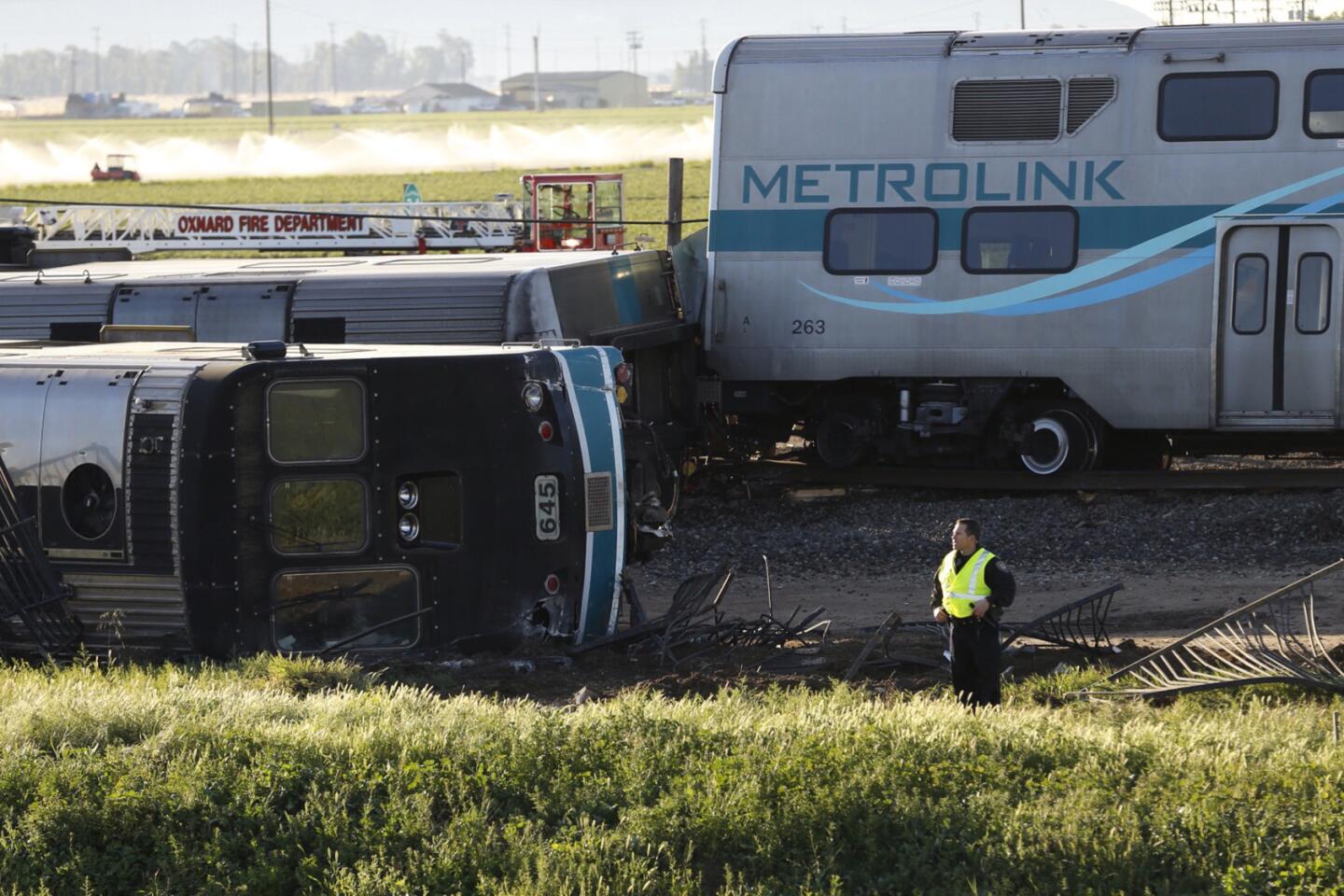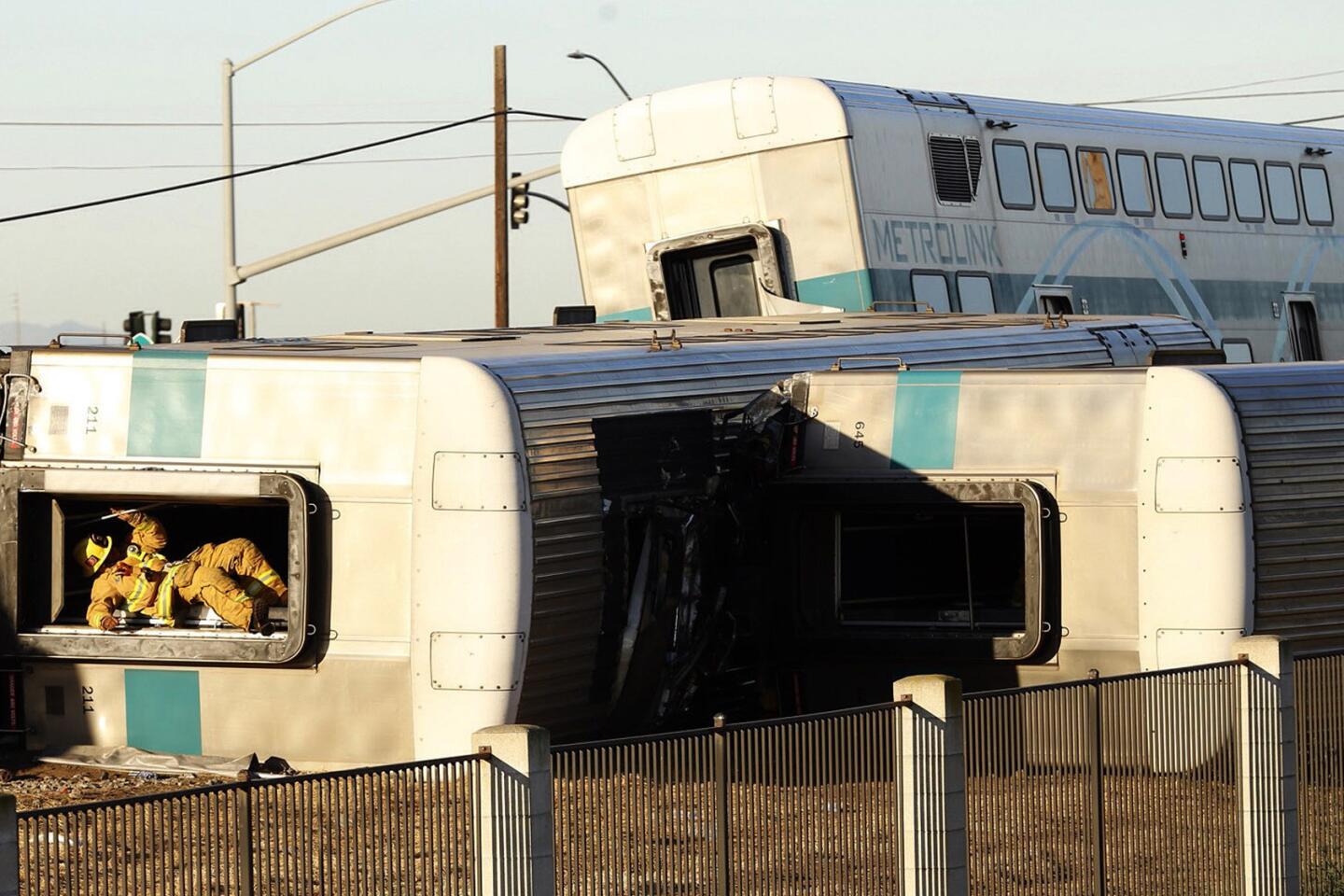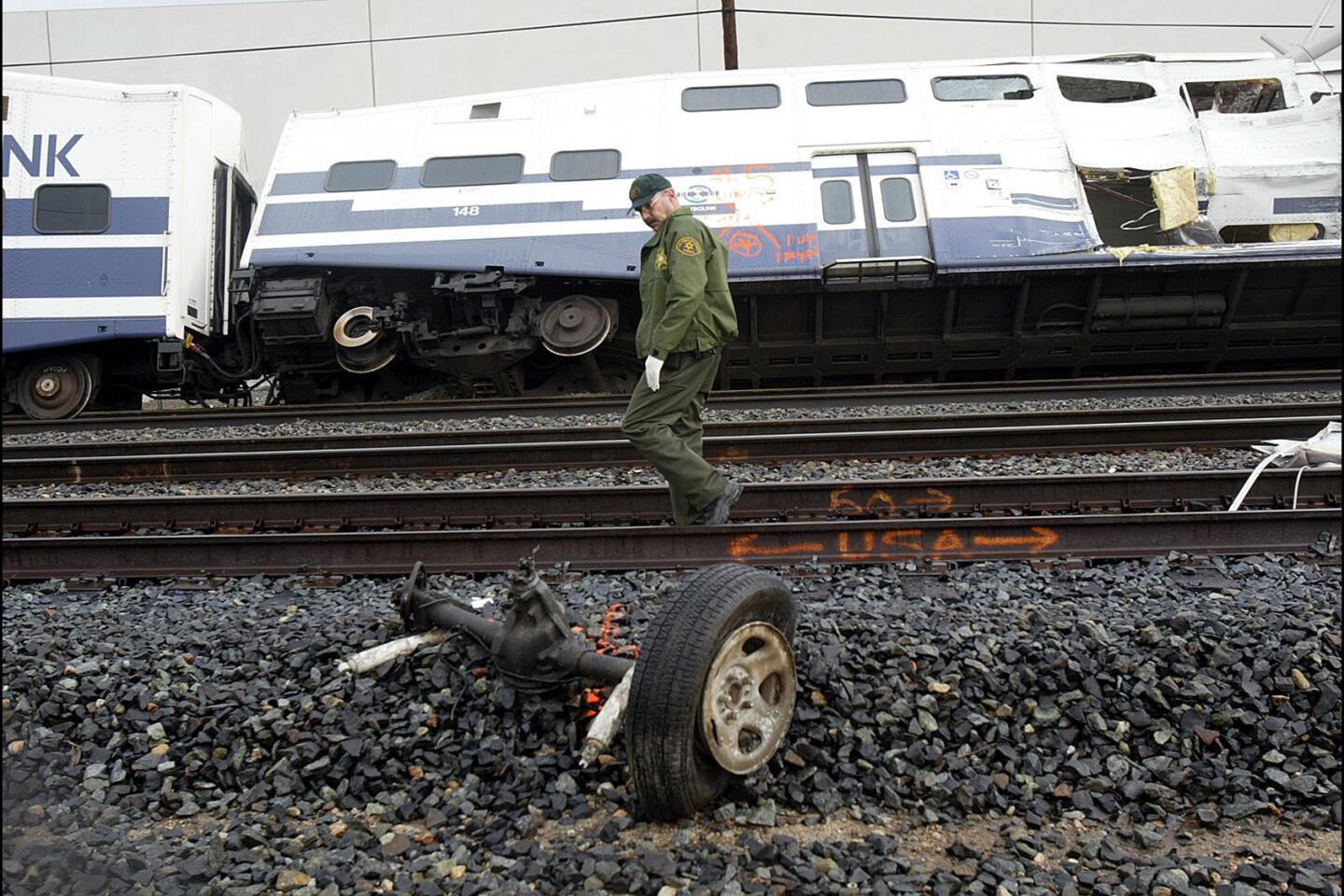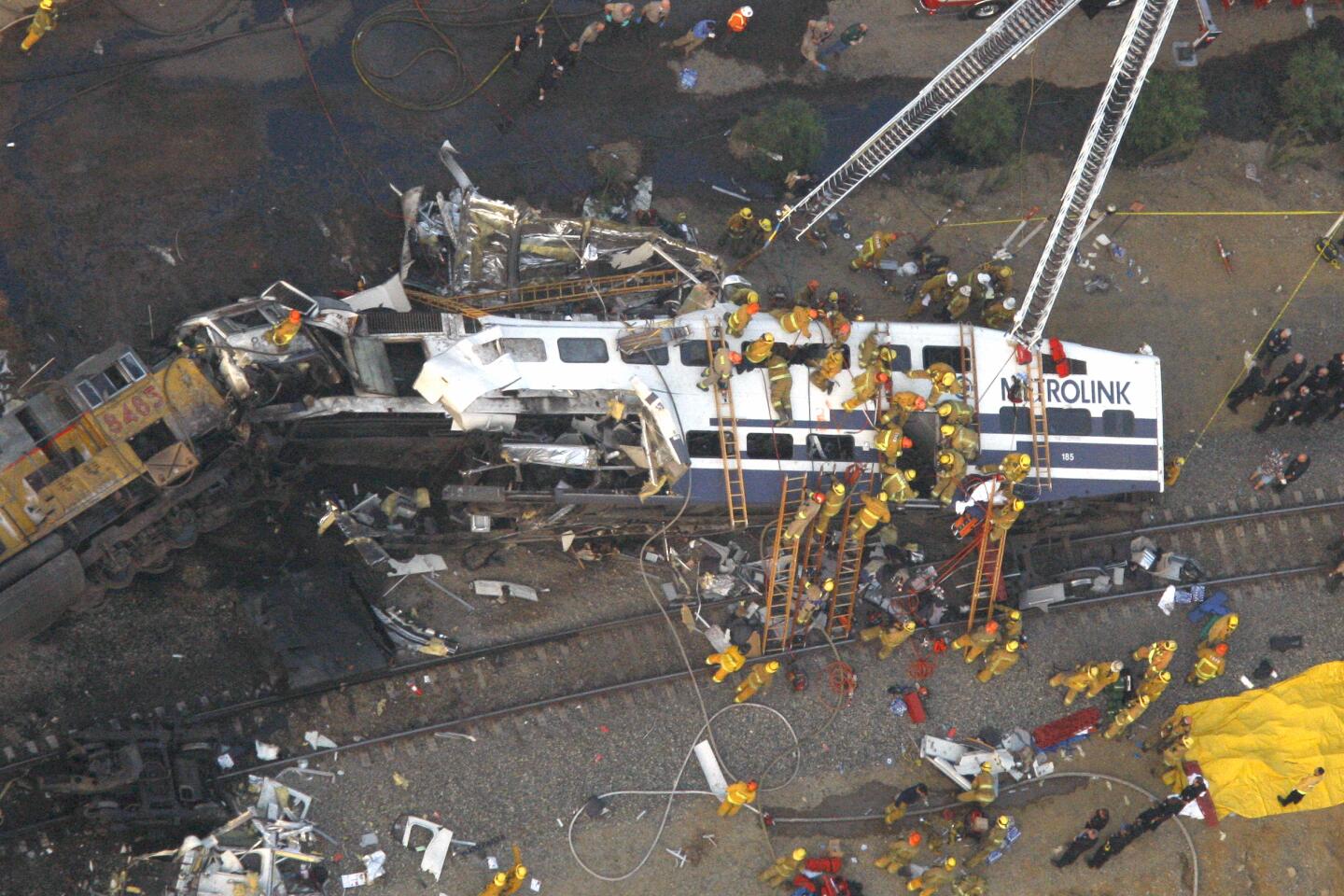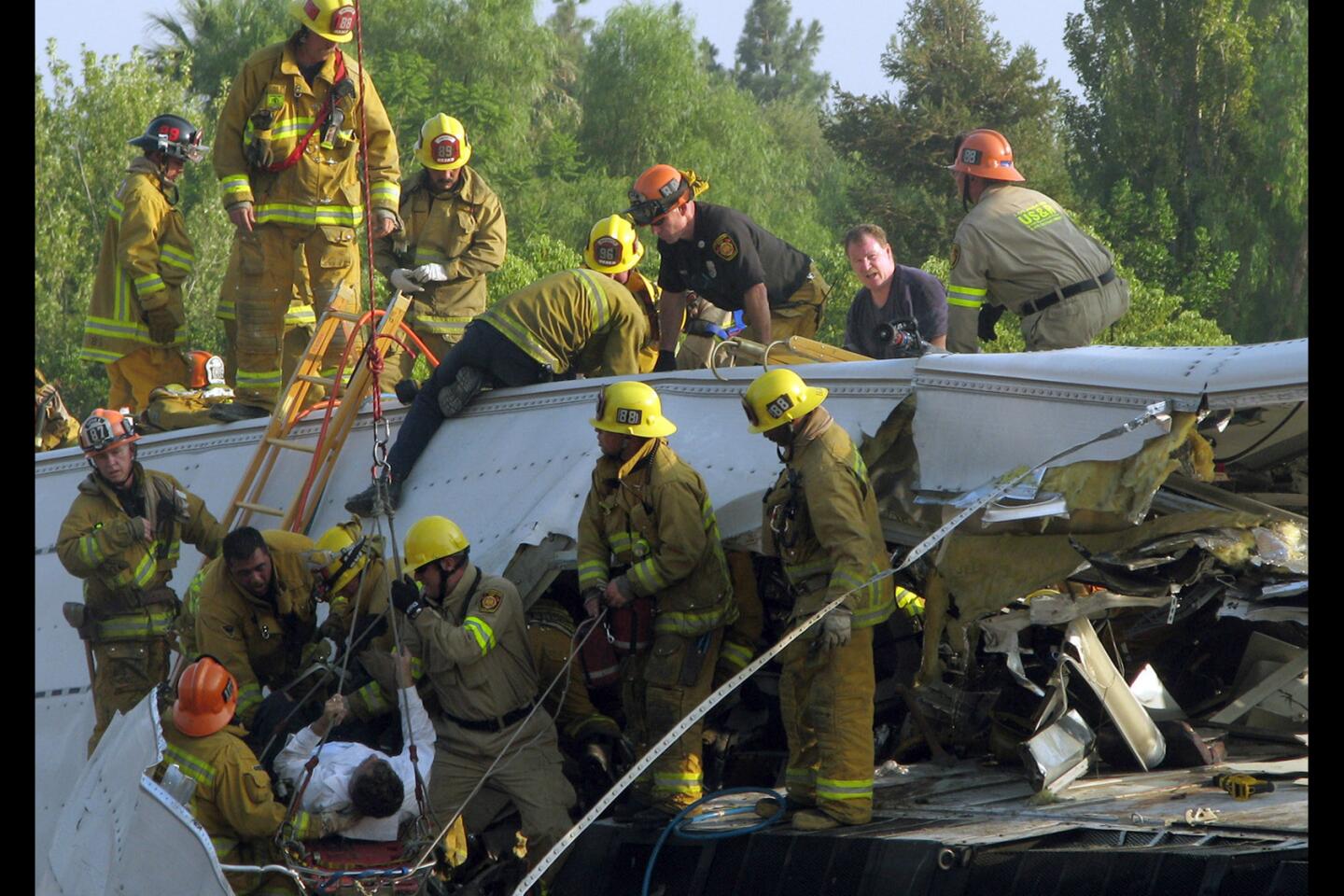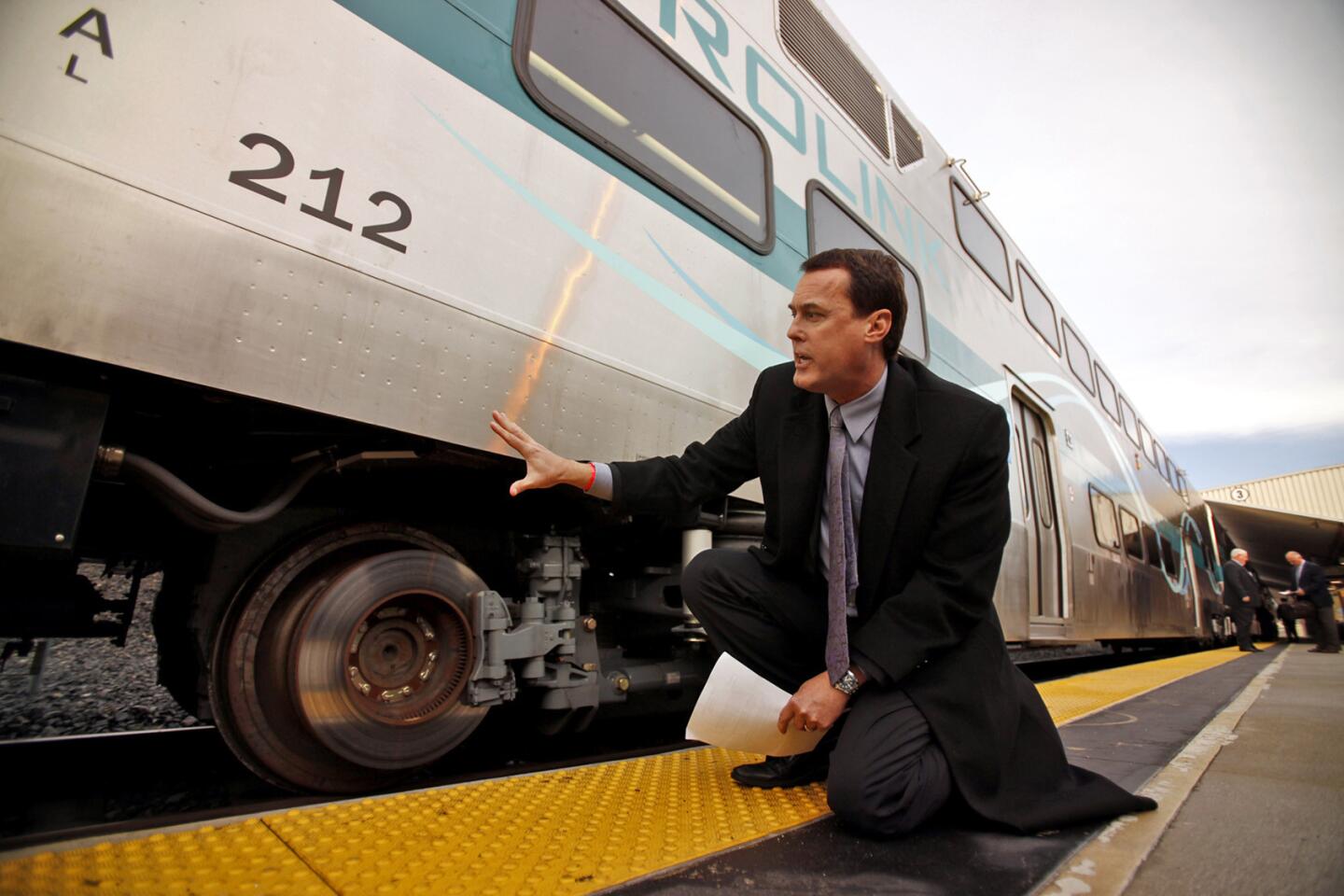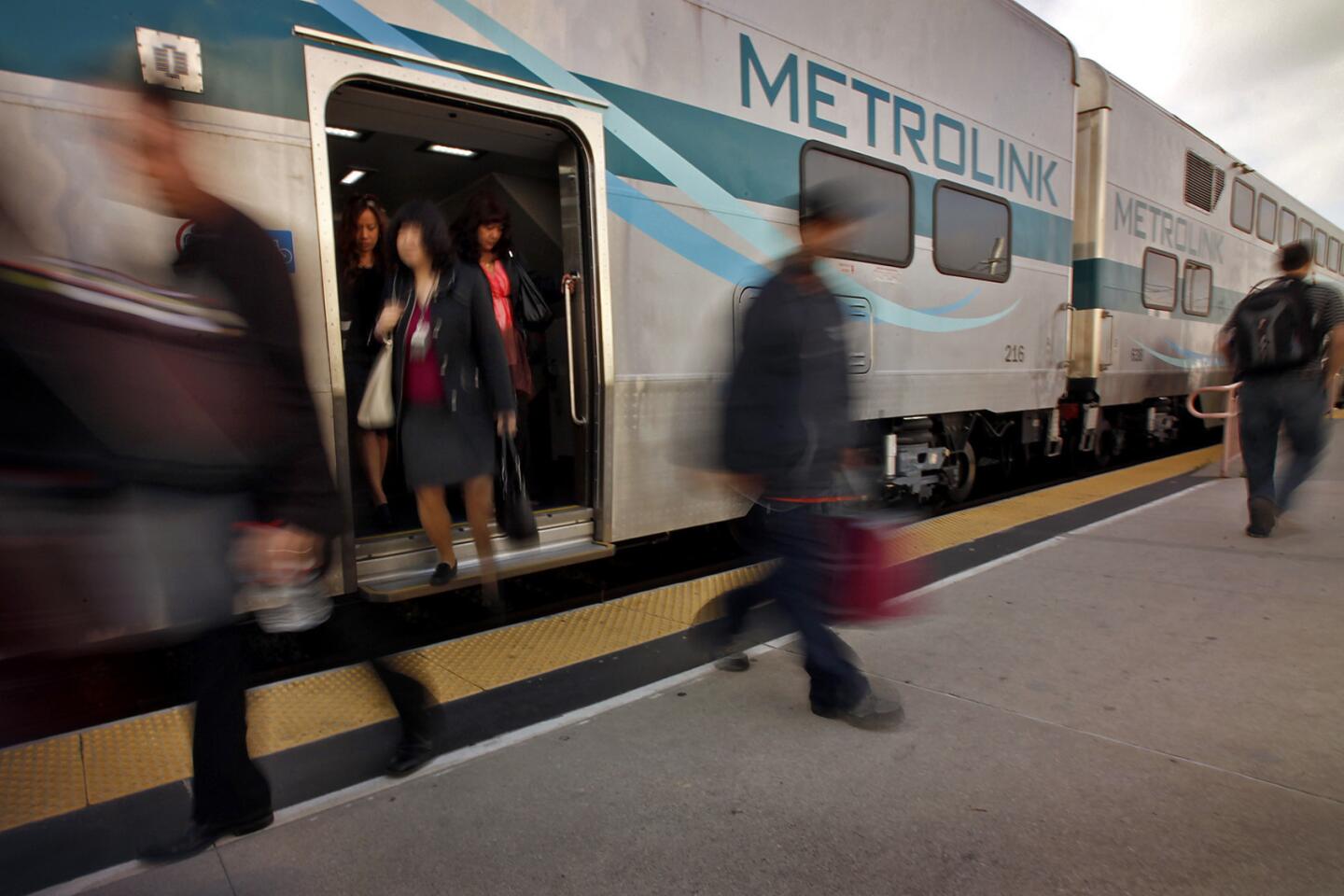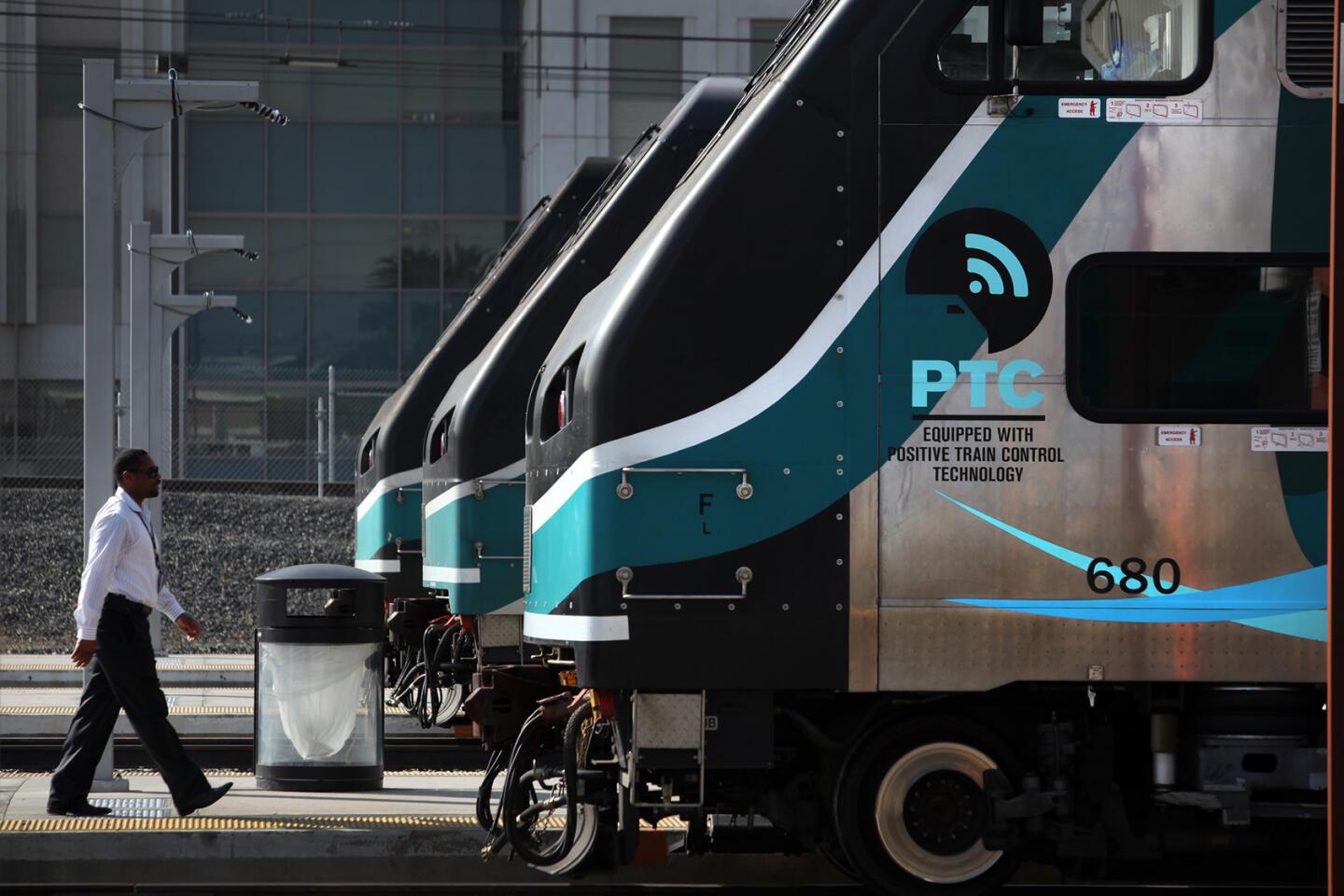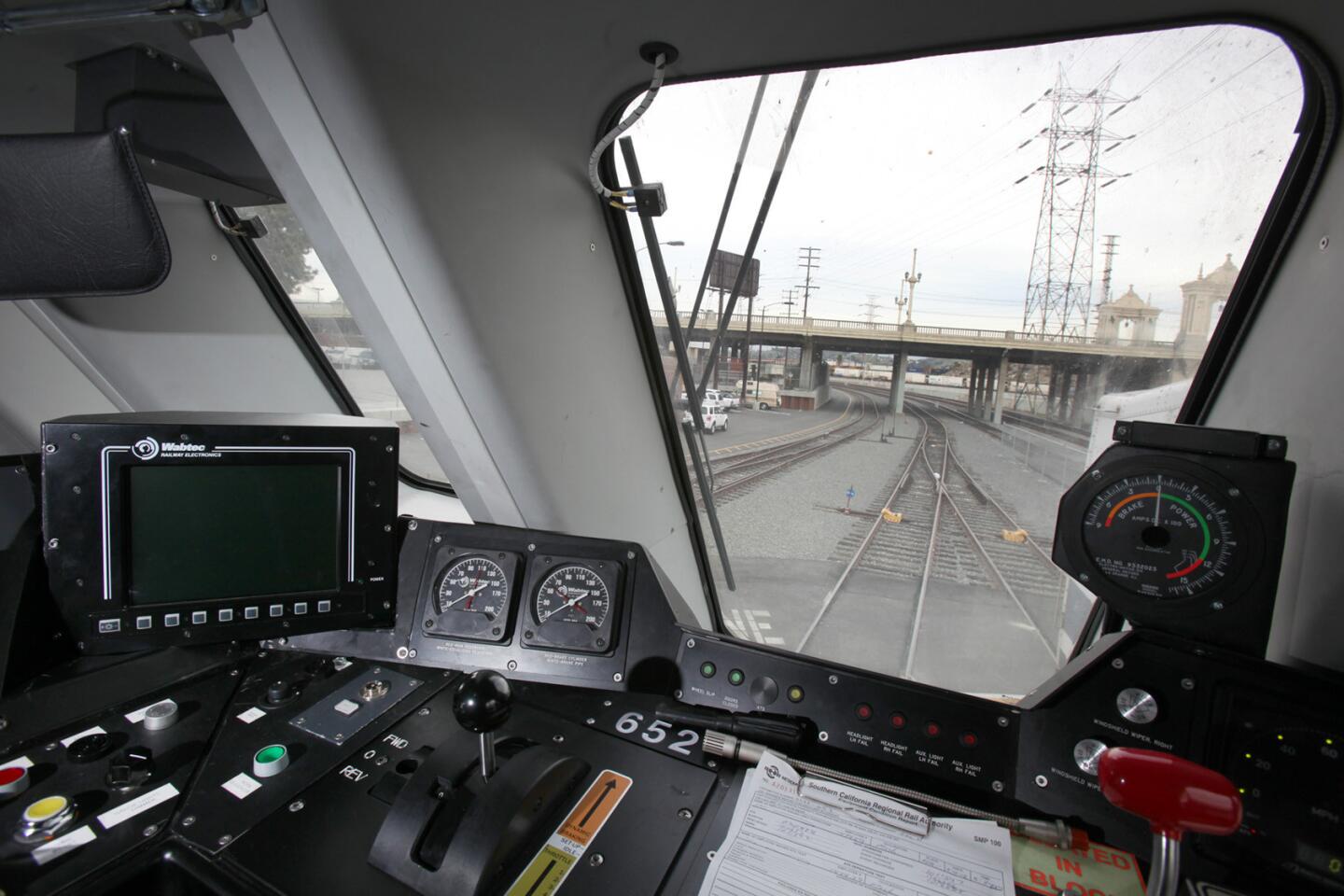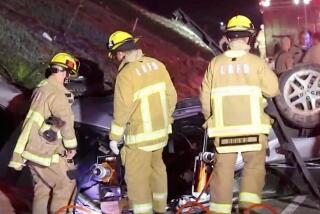From the archives: Death on the rails in L.A.
Although Metrolink safety lapses drew national attention last year when 25 people were killed in a head-on collision with a freight train, many more have died from commuter trains hitting automobiles and pedestrians.
Over the 15 years leading up to the deadly crash in Chatsworth, accidents involving trains running on Metrolink’s system killed 218 other people, according to a detailed examination of accident records by The Times. Through September 2008, the number killed on the Metrolink commuter rail system was 244. Hundreds more people sustained nonfatal injuries.
Critics say Metrolink leaders have not paid enough attention to safety and have done little to upgrade dangerous intersections where streets cross the tracks. In particular, the public railway has failed to adopt the sorts of safety systems and improvements developed and widely used by its sister agency, the Metropolitan Transportation Authority.
Some of the clearest examples are in the San Fernando Valley, which includes two of Metrolink’s most dangerous crossings -- at Buena Vista Street in Burbank and Sunland Boulevard in Sun Valley.
For the thousands of motorists who pass through it every day, the rail crossing at Buena Vista and San Fernando Boulevard can be a hair-raising passage. The intersection is a maze of sharp turns and confusing signals that require drivers to move with split-second timing.
Twice in recent years, that timing has gone fatally wrong just as a train was bearing down fast, leading to the deaths of motorists.
On Jan. 6, 2003, Jacek “Jack” Wysocki rolled his Ford truck into the path of a Metrolink train traveling 79 mph. The 63-year-old driver was killed along with one train passenger; two train cars derailed and flipped, injuring 20 other Metrolink riders.
Exactly three years later, 76-year-old Maureen Osborn was killed after turning in front of a Metrolink commuter going 75 mph. Osborn’s car was dragged a third of a mile before the train could stop.
Both tragedies could have been predicted. Buena Vista and similar Metrolink intersections had all seen previous accidents and near-collisions.
Metrolink took no responsibility
They also could have been prevented. But if any Metrolink official saw trouble coming, records show no evidence of action. After each accident, leaders of the regional rail system took no responsibility, choosing instead to invoke a standard industry convention: They blamed the deaths on motorists who “tried to beat the train.”
Even after a blistering 2003 critique of the crossing’s design and signal system by the National Transportation Safety Board, nothing was done to correct Buena Vista’s flaws. Facing no legal obligation to follow federal recommendations, Metrolink, Burbank authorities and the California Public Utilities Commission -- the state agency responsible for train safety -- made only minor refinements.
One expert says the history behind the Buena Vista-San Fernando crossing reveals a glaring flaw in the mind-set of Metrolink leaders: Because they have focused more on building ridership than on improving safety, even hazards that could have been eliminated or sharply reduced have been allowed to remain. Only after the horrific Chatsworth crash did Metrolink upgrade the status of its safety unit so that it reported directly to chief executive David R. Solow.
“I call it the culture of denial and deflection,” said Najmedin Meshkati, a professor of engineering at USC whose studies of human factors in accidents have led him to become a vocal critic of Metrolink.
That culture also stands in stark contrast to what is practiced by the MTA, the largest of five rail agencies that contribute funds to Metrolink.
That agency, based only blocks from Metrolink’s Los Angeles office, also had a record of numerous accidents and deaths after initiating its Blue Line light-rail service between downtown and Long Beach in 1990. Since then, the MTA’s safety section has examined the causes and retrofitted many of the worst crossings with systems to prevent accidents. As a result, the Blue Line accident rate has dropped significantly.
Despite numerous requests by The Times, Metrolink did not allow any technical officials to be interviewed for this report or to answer written questions.
Richard Katz, an MTA board member who was appointed to the Metrolink board by Los Angeles Mayor Antonio Villaraigosa after the Chatsworth crash, acknowledged that Metrolink hasn’t “always maintained the vigilance that is necessary.”
As an example, Katz said, Metrolink’s “shoe box” record keeping is inadequate to analyze accident trends.
“I think that MTA has had a better consciousness of safety in the past than Metrolink has, even though Metrolink has tried,” Katz said. “Our goal is to try to get safety at the same level at Metrolink as the MTA. I don’t think we’re there yet, but that’s the place we’re trying to get to. I think in the last year, there has been a remarkable turnaround, but it still has a long way to go.”
Katz said many of Metrolink’s deficiencies resulted from chronic under-funding: Most of its revenue is contributed by larger county transit agencies, including the MTA and the Orange County Transportation Authority. But, although Metrolink’s board has embarked on a multiyear billion-dollar technological program to prevent another Chatsworth-like crash, it has yet to undertake less costly measures that would lessen the day-to-day hazards.
In reviewing Metrolink’s history from its 1993 inception through 2008, The Times performed a computer analysis of all accidents and the recorded near-collisions on the rail service’s 388-mile system, including its own track and track maintained by other passenger or freight lines.
The analysis found that a few so-called grade level street crossings -- the Buena Vista intersection among them -- had a particularly high number of accidents or near-collisions. Twelve locations account for about one in five crossing accidents, and of all accidents, nearly one in four were along a 17-mile corridor in the San Fernando Valley. The most dangerous intersection was Sunland Boulevard at San Fernando Road in Los Angeles, at which there were 13 incidents. Buena Vista, with nine, had the second-worst record.
The concentration suggests that Metrolink could reduce accidents significantly without a costly program to retrofit hundreds of crossings.
In practice, however, the agency has ceded crossing improvements to cities in its system. As a result, money is not always directed where lives are most at risk.
Glendale recently spent $4 million to build a new crossing -- complete with the latest safety devices -- at lightly traveled Flower Street. Its purpose is to accommodate future expansion of the Grand Central Business District, said public works director Steven M. Zurn. He said two more crossings are in the city’s plans.
But little or no upgrading has been done at other crossings on the north Valley route despite extensive accident histories.
Potential trouble at an intersection
As is the case at many of the problem crossings, several factors raise the potential for trouble at the Buena Vista-San Fernando intersection -- shaped almost like an H leaning 45 degrees to the left:
* The Metrolink tracks parallel San Fernando and cross Buena Vista, which runs north-south, at an oblique angle, requiring some drivers to look over their shoulders to spot approaching trains.
* A nearby exit ramp from the 5 Freeway disgorges a constant flow of cars and big-rig trucks into the intersection.
* A complex signal pattern and double left-turn lane have the potential to back up cars trying to head south onto San Fernando Boulevard. The congestion means that despite “Keep Clear” signs, almost every red light traps one or more cars briefly on the track.
Although Metrolink accepted no responsibility for the death of Wysocki in 2003, the National Transportation Safety Board said the intersection’s design and traffic lights were contributing factors.
As Wysocki approached the crossing in his stake-bed truck that morning, preparing to turn left across the tracks from San Fernando, the traffic lights hanging over the intersection were red. But as the train approached over his left shoulder, the arrow began to flash. That was meant to let drivers on San Fernando know they could continue going straight. But NTSB investigators concluded that Wysocki thought the flashing left-turn arrow meant he could start his turn.
A lowered crossing gate on Buena Vista should have blocked his path. But because of the intersection’s sharp angle, it did not extend far enough into the street. Wysocki had space to drive around it by swinging across the oncoming left-turn lane.
The NTSB report recommended that the city reprogram the left-turn arrow to remain solid and build a median to prevent cars from cutting the corner.
However, the California Public Utilities Commission conducted its own study of Buena Vista and the rest of Metrolink’s north Valley corridor after a rash of fatal accidents within a month of Wysocki’s death.
It reached a far different conclusion, calling it “a matter of coincidence” that so many accidents had occurred so close together. It found that in each case, the driver either disobeyed traffic laws or was committing suicide. No changes were recommended.
City of Burbank traffic engineer Ken Johnson said he believes the NTSB proposals actually would have made the intersection less safe. Big-rig trucks exiting the 5 Freeway can be stopped in the intersection when a train comes, he said. The flashing red lights allow them to go through the intersection.
Three years to the day after Wysocki’s death, Osborn was struck and killed by a train while turning onto Buena Vista from San Fernando, this time from the right.
Eyewitness Vince Pace said he had no doubt what caused the elderly woman to drive her car into the train’s path.
Coming to a stop at a red light on San Fernando, Osborn paused and then began to turn right.
Pace, watching from a car nearby, believes she saw no warning of an approaching train. Although the intersection is equipped with a crossing sign and signal lights, they face south on Buena Vista and are not easily seen from San Fernando. Pace said he believes Osborn made what she thought was a legal turn.
“I remember looking at that and saying, ‘How odd. The person doesn’t have an indicator saying wait a minute, a train is coming.’ ”
Pace said he could see her confusion, looking up at the descending railroad crossing bar, trying to decide what to do. Then she gunned the car forward. Metrolink officials concluded that Osborn was trying to beat the train.
“It’s impossible to tell the speed of an oncoming train,” said Denise Tyrrell, former Metrolink spokeswoman. “She may have seen the train and believed she could judge how fast it was moving.”
Pace said he was outraged when he heard that assessment. Osborn “was very much aware that something was wrong and that the consequences of that were death,” he said. “That’s not running. It’s really unfortunate they took that stance. But that’s the best thing they could say instead of a 70-year-old woman was confused.”
Osborn’s son, Jim, who now lives in Michigan, has for years lobbied California officials for modifications he believes would have prevented his mother’s death. He wants more signs, more flashing lights and a clearer message to warn when a train is coming.
MTA uses more safety measures
Many of the measures Jim Osborn advocates have been put to use by the Metrolink’s sister agency, the MTA. It has introduced warning systems, redesigned crossings, ordered that trains slow down at dangerous spots, launched public safety campaigns and recently installed photo enforcement cameras -- all to prevent drivers and pedestrians from making fatal mistakes. Among its innovations is what it calls the “quad” crossing, with guard arms that descend on all lanes leading to and from a track crossing.
The MTA received approval from the PUC to use “quads” across its system. It is now standard on all new routes, including the Gold Line extension, and the agency is adding it to some older track. MTA crossings also incorporate an overhead warning system that lights up a train icon, warning motorists when trains are approaching.
Johnson, Burbank’s traffic engineer, said the city did make some changes to the Buena Vista-San Fernando intersection after Wysocki’s death. It improved electronic equipment to ensure proper timing of the warning system.
Johnson said the city spent more than a year planning other improvements and had purchased illuminated “No Turn” signs to be placed on San Fernando Boulevard. But it never completed that part of the project, he said.
It took the PUC 18 months to sign off on the plan, he said. But by that time, California Department of Transportation officials announced that Buena Vista would undergo a multimillion-dollar intersection overhaul that would separate vehicle and train traffic as part of a widening of Interstate 5.
“When Caltrans said they were going to widen I-5, we decided it was moot,” Johnson said.
Earlier this year, Johnson said he expected the widening to begin in April. It didn’t. A spokeswoman for Caltrans said the project is still in design and won’t begin at least until the fall of 2010. In the meantime, thousands of drivers use the intersection as nearly 50 Metrolink trains pass through each day.
Times staff writer Nathan Olivares-Giles, researcher Maloy Moore and data analyst Sandra Poindexter contributed to this report.
More to Read
Sign up for Essential California
The most important California stories and recommendations in your inbox every morning.
You may occasionally receive promotional content from the Los Angeles Times.
